Caring For Your Corn Snake

Corn Snakes
Click on "more photos" to see additional morph examples which may include hatchling, yearling, sub-adult, adult, scale close-up, ventral (belly), pippy and "blue phase" photos.

Abbott's Okeetee Corn Snake
This Okeetee morph was achieved through selective breeding for thick, black borders. The black borders really compliment the beautiful combinations of brown, orange, red, yellow, and white scale colors that can be found on an Okeetee.

Amber Corn Snake
Amber corn snakes are a combination of the caramel and hypo genes. Their scale colors can be lovely combinations of tan, golden brown and grey with touches of yellow.
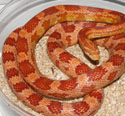
Amelanistic Corn Snake
Amelanistic (amel) corn snakes do not have the dark pigment, thus giving them red eyes and leaving bright color combinations of red, orange, yellow and white for the scale colors. They are sometimes referred to as "red albinos."
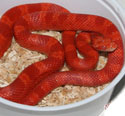
Amelanistic Bloodred Corn Snake
Amel Bloodreds, sometimes known as Fires, are a combination of the Amelanistic and Bloodred genes. Ideal specimens have nicely diffused sides and little or no white when mature."
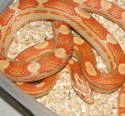
Amelanistic Motley Corn Snake
Amelanistic (Amel) Motley corn snakes do not have the dark pigment, thus giving them red eyes and leaving bright color combinations of red, orange, yellow and white for the scale colors. They are a combination of the Amel and Motley genes.
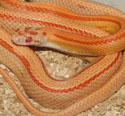
Amelanistic Stripe Corn Snake
Amelanistic Stripe corn snakes are a combination of the Amel and Stripe genes. They do not have the dark pigment, thus giving them red eyes and leaving bright color combinations of red, orange and yellow for the scale colors.
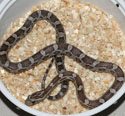
Anerythristic Corn Snake
Anerythristic corn snakes (Anery A) do not have the red pigment. So, their scale colors are combinations of black and grey with some developing yellow on the lower jaw-line/neck area.
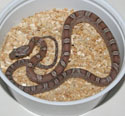
Anerythristic Bloodred Corn Snake
Anery Bloodreds (sometimes known as Granites) are a combination of the Anerythristic A and Bloodred genes. Look for nice side diffusion. The bloodred gene eliminates the belly checkers.
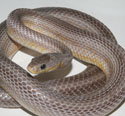
Anerythristic Bloodred Stripe Corn Snake
These are a combination of three genes... Anery A, Bloodred, and Stripe. Their scale colors are shades of grey with yellow developing on some as they mature. These snakes are also referred to as Granite Stripe corn snakes.
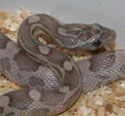
Anerythristic Lavender Corn Snake
Anery Lavenders are a combination of the Anerythristic A and Lavender genes. Their scale colors are shades of grey. In my lines, the males are typically lighter than the females.
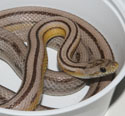
Anerythristic Stripe Corn Snake
Anerythristic (Anery A) Stripe corn snakes do not have the red pigment. So, their scale colors are combinations of black and grey with some developing yellow on the lower jaw-line/neck area.

Blizzard Corn Snake
Blizzards are a combination of the Charcoal and Amelanistic genes. Some mature to be solid white (like my female named Snow White) while others may develop light yellow belly checkers and/or "lemon-lined" saddles.
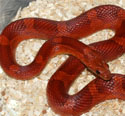
Bloodred Corn Snake
Bloodreds are stunning red corn snakes. Look for nice side diffusion (no side pattern) and little or no black outlining the saddles. The bloodred gene also eliminates the belly checkers.

Bloodred Stripe Corn Snake
Bloodred Stripes are stunning corn snakes. With the deep red color and dark eyes, they are definitely one of my all time favorites.
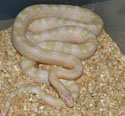
Bubblegum Snow Corn Snake
These corn snakes have also been called "pink and green" snow corns, but not all of them will develop green on them. They are snows that have been selectively bred for their pink coloring. Their scale colors may include shades of yellow, pink, green and white.

Bubblegum Snow Stripe Corn Snake
By adding the stripe gene to a line-bred, pink Bubblegum Snow corn snake, you get this pretty snake. Their scale colors are white, and shades of pink. Some develop a nice yellow color along the jaw-line/neck area.
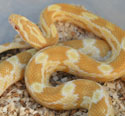
Butter Corn Snake
This corn snake was named for it's beautiful, yellow coloring. Butter corn snakes are a combination of the Caramel and Amelanistic genes.
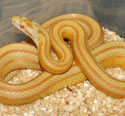
Butter Stripe Corn Snake
Combine the Amelanistic, Caramel, and Stripe genes, and this is the gorgeous corn snake you get. The Butter Stripe is stunning with it's various shades of yellow and white belly.

Caramel Corn Snake
Caramel corn snakes definitely live up to their name. They have scale colors that are shades of brown, golden caramel color, yellow and black.

Caramel Motley Corn Snake
Caramel Motley corn snakes are a combination of both the Caramel and Motley genes. They definitely live up to their name... having scale colors that are shades of brown, golden caramel color, yellow and black.
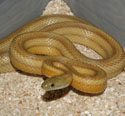
Caramel Stripe Corn Snake
These corn snakes are homozygous for both the Caramel and Stripe genes. They definitely live up to their name having scale colors that are shades of brown, golden caramel color and yellow.
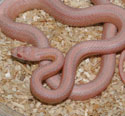
Champagne Snow Stripe Corn Snake
Champagne Snow Stripe corn snakes are a combination of the Amelanistic, Anerythristic (Anery A), and Stripe genes. It's unknown if these snakes are homozygous for Hypo. Breeding trials will help us determine if there's something else at work to give these snakes their color.
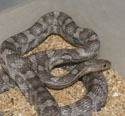
Charcoal Corn Snake
Charcoal corn snakes (sometimes called Anery B) don't have red pigment, thus giving them grey and black scales. These corn snakes have a different eye color and less contrast between the gound and saddle color than the Anery A corn snakes. Some do develop light yellow on the lower jaw line/neck area.
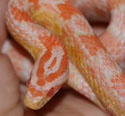
Coral Snow Corn Snake
My Coral Snows have been proven to be a combination of three genes... Anerythristic, Amelanistic and Hypomelanistic A. These stunning corn snakes are gorgeous shades of orange, pink, yellow and white. Some may even develop light green borders.

Ghost Corn Snake
This corn snake is the combination of the Anerythristic (Anery A) and Hypomelanistic genes. The scale colors can include white, grey, brown and black.
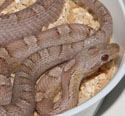
Ghost Bloodred Corn Snake
Ghost Bloodreds are a combination of the Anerythristic A, Hypomelanistic (Hypo A) and Bloodred genes. Their scale colors are shades of brown with some developing yellow on the lower jaw-line and neck area. Look for nice side diffusion. The bloodred gene eliminates the belly checkers.
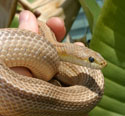
Ghost Stripe Corn Snake
This corn snake is the combination of the Anerythristic (Anery A), Hypomelanistic (Hypo A), and Stripe genes. These corn snakes are various shades of brown and yellow.

Hypomelanistic (Hypo A) Corn Snake
When adding the Hypo gene to a "normal" corn snake, some of the black pigment is taken away. So, the black is reduced and the colors are lighter/brigher than those found on a normal corn snake.
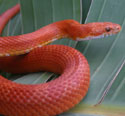
Hypo Bloodred Corn Snake
This corn snake was created by combining both the Hypomelanistic and Bloodred genes. Adding the Hypo gene removes some of the dark pigment which lightens the bloodred color. The bloodred gene eliminates the belly checkers.
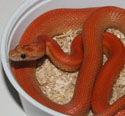
Hypomelanistic Stripe Corn Snake
This corn snake is a combination of the Hypo and Stripe genes. Their scale colors are beautiful shades of yellow, orange, and redish brown.

Hypo Lavender Corn Snake
These corn snakes are a combination of the Lavender and Hypomelanistic genes. They can be various shades of light lavender or greyish-lavender. Hypo Lavenders may also have a peach ground color.

Hypo Lavender Stripe Corn Snake
These corn snakes are a combination of three genes... Lavender, Hypomelanistic, and Stripe. Their color can be shades of lavender and a "pinkish" lavender.

Lavender Corn Snake
Lavender corn snakes were originally called Mochas. Hatchlings can vary from a brownish to more of a lavender color. As adults, their colors can vary from shades of greyish lavender to a very colorful lavender with hints of peach.
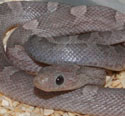
Lavender Bloodred Corn Snake
Lavender Bloodreds (also known as Plasma corn snakes) are a combination of the Lavender and Bloodred genes. Scale colors are various shades of lavender with some having a peachy ground color. Look for nice side diffusion (lack of side pattern). The Bloodred gene also eliminates the belly checkers.
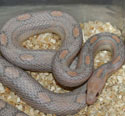
Lavender Motley Corn Snake
These corn snakes are a combination of the Lavender and Motley genes. Hatchlings can vary from a brownish to more of a lavender color. As adults, their colors can vary from shades of greyish lavender to a very colorful lavender with hints of peach.

Miami Corn Snake
The name "Miami Corn Snake" has two meanings. It can refer to the locality, wild corn found in Florida. It's also a corn snake that has been selectively bred for it's coloring. The saddle colors can range from a brown to a redish-burgandy with ground colors of tan to silverish-grey. Some may develop touches of orange.

Normal Corn Snake
Normal corn snakes (sometimes called Classics) have scale colors like those corns that are found in the wild. Their scale colors can be combinations of brown, orange, red, golden yellow and black.
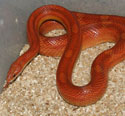
Normal Motley Corn Snake
These corns snakes are homozygous for the Motley gene. Their scale colors can be combinations of brown, orange, red, golden yellow and black.

Normal Stripe Corn Snake
If you take a "Normal" corn snake and add the Stripe gene, then this is the pretty snake you get. Their scale colors can be combinations of brown, orange-ish brown, and golden yellow.

Opal Corn Snake
Opal corn snakes are a combination of the Lavender and Amelanistic genes. Much like the Opal gemstone, their adult colors are usually pink-ish white with shimmers of darker pink and peach type colors.
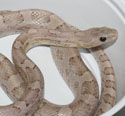
Phantom Corn Snake
Phantom corn snakes are a combination of the Hypomelanistic A (Hypo) and Charcoal genes. They have a light grey appearance with some developing yellow on the lower jaw-line/neck area.

Reverse Okeetee Corn Snake
Reverse Okeetees are selectively bred Amels for the nice, wide borders. Their scale colors can be combinations of red, orange, yellow and white. As adults the border colors can vary from a white to a light green.

Snow Corn Snake
Snows are a combination of the Amelanistic and Anerythristic (Anery A) genes. As hatchlings, most snow corn snakes look similar. As they mature, their colors vary and can include shades of yellow, pink, green and white.

Snow Motley Corn Snake
Snow Motley corn snakes are a combination of the Amelanistic, Anerythristic (Anery A), and Motley genes. As hatchlings, most snow corn snakes look similar. As they mature, their colors vary and can include shades of yellow, pink, green and white.
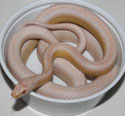
Snow Stripe Corn Snake
Snow Stripes are a combination of the Amelanistic, Anerythristic, and Stripe genes. As hatchlings, most snow stripe corn snakes look similar. As they mature, their colors vary and can include shades of yellow, pink, and white.
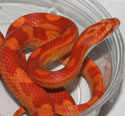
Sunglow Motley Corn Snake
Sunglow Motley corn snakes are Amel Motleys that have been selectively bred for their stunningly bright colors. They are a combination of the Amel and Motley genes.

Sunglow Stripe Corn Snake
Sunglow Stripe corn snakes were produced by selectively breeding Amelanistic Stripes for the stunningly bright red, orange and yellow colors. Many Sunglow Stripes are nearly patternless when mature with scale colors that are red or redish-orange blending to a bright, golden yellow.
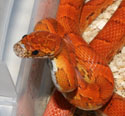
Sunkissed Corn Snake
The sunkissed gene is a considered to be a hypomelanistic gene (Hypo C). Sunkissed corn snakes usually have a distinct type of head pattern with square shaped saddles.

Ultramel Corn Snake
These corn snakes have two co-dominant genes... Ultra and Amel. This means that you will get Ultramels in the first generation if you breed it to a morph that is homozygous for Amel (i.e. a Snow, Amel, Butter etc.)
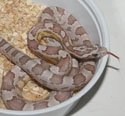
Ultramel Anery Corn Snake
This corn snake has the two codominant genes of Ultra and Amel in it... as well as being homozygous for Anery. These beautiful corn snakes have a blue iris, ruby pupil, and various shades of grey scales. Some develop yellow on the jaw-line and neck area.